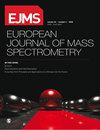GC-MS based metabolite fingerprinting of serous ovarian carcinoma and benign ovarian tumor
IF 0.8
4区 化学
Q4 PHYSICS, ATOMIC, MOLECULAR & CHEMICAL
引用次数: 1
Abstract
The aim of this study is to identify urinary metabolomic profile of benign and malign ovarian tumors patients. Samples were analyzed using gas chromatography-mass spectrometry (GC-MS) and metabolomic tools to define biomarkers that cause differentiation between groups. 7 metabolites were found to be different in patients with ovarian cancer (OC) and benign tumors (BT). R2Y and Q2 values were found to be 0.670 and 0.459, respectively. L-tyrosine, glycine, stearic acid, turanose and L-threonine metabolites were defined as prominent biomarkers. The sensitivity of the model was calculated as 90.72% and the specificity as 82.09%. In the pathway analysis, glutathione metabolism, aminoacyl-tRNA biosynthesis, glycine serine and threonine metabolic pathway, primary bile acid biosynthesis pathways were found to be important. According to the t-test, 29 metabolites were found to be significant in urine samples of OC patients and healthy controls (HC). R2Y and Q2 values were found to be 0.8170 and 0.749, respectively. These results showed that the model has high compatibility and predictive power. Benzoic acid, L-threonine, L-pyroglutamic acid, creatinine and 3,4-dihydroxyphenylacetic acid metabolites were determined as prominent biomarkers. The sensitivity of the model was calculated as 93.81% and the specificity as 98.59%. Glycine serine and threonine metabolic pathway, glutathione metabolism and aminoacyl-tRNA biosynthesis pathways were determined important in OC patients and HC. The R2Y, Q2, sensitivity and specificity values in the urine samples of BT patients and HC were found to be 0.869, 0.794, 91.75, 97.01% and 97.18%, respectively. L-threonine, L-pyroglutamic acid, benzoic acid, creatinine and pentadecanol metabolites were determined as prominent biomarkers. Valine, leucine and isoleucine biosynthesis and aminoacyl-tRNA biosynthesis were significant. In this study, thanks to the untargeted metabolomic approach and chemometric methods, every group was differentiated from the others and prominent biomarkers were determined.基于GC-MS的浆液性卵巢癌和卵巢良性肿瘤代谢物指纹图谱
本研究的目的是确定良性和恶性卵巢肿瘤患者的尿液代谢组学特征。使用气相色谱-质谱(GC-MS)和代谢组学工具对样品进行分析,以确定导致组间差异的生物标志物。发现卵巢癌症(OC)和良性肿瘤(BT)患者的7种代谢产物存在差异。R2Y和Q2的值分别为0.670和0.459。L-酪氨酸、甘氨酸、硬脂酸、turanase和L-苏氨酸代谢产物被定义为显著的生物标志物。该模型的敏感性为90.72%,特异性为82.09%。在途径分析中,谷胱甘肽代谢、氨酰基tRNA生物合成、甘氨酸-丝氨酸和苏氨酸代谢途径、初级胆汁酸生物合成途径是重要的。根据t检验,在OC患者和健康对照(HC)的尿液样本中发现29种代谢产物具有显著性。R2Y和Q2的值分别为0.8170和0.749。这些结果表明,该模型具有很高的兼容性和预测能力。苯甲酸、L-苏氨酸、L-焦谷氨酸、肌酸酐和3,4-二羟基苯乙酸代谢产物被确定为显著的生物标志物。该模型的敏感性为93.81%,特异性为98.59%。甘氨酸-丝氨酸和苏氨酸代谢途径、谷胱甘肽代谢和氨酰基-tRNA生物合成途径在OC患者和HC中具有重要意义。BT患者和HC的R2Y、Q2、敏感性和特异性分别为0.869、0.794、91.75、97.01%和97.18%。L-苏氨酸、L-焦谷氨酸、苯甲酸、肌酸酐和十五醇代谢产物被确定为显著的生物标志物。缬氨酸、亮氨酸和异亮氨酸的生物合成以及氨酰基tRNA的生物合成显著。在这项研究中,由于采用了非靶向代谢组学方法和化学计量方法,每个组都与其他组进行了区分,并确定了突出的生物标志物。
本文章由计算机程序翻译,如有差异,请以英文原文为准。
求助全文
约1分钟内获得全文
求助全文
来源期刊
CiteScore
2.40
自引率
7.70%
发文量
16
审稿时长
>12 weeks
期刊介绍:
JMS - European Journal of Mass Spectrometry, is a peer-reviewed journal, devoted to the publication of innovative research in mass spectrometry. Articles in the journal come from proteomics, metabolomics, petroleomics and other areas developing under the umbrella of the “omic revolution”.

 求助内容:
求助内容: 应助结果提醒方式:
应助结果提醒方式:


